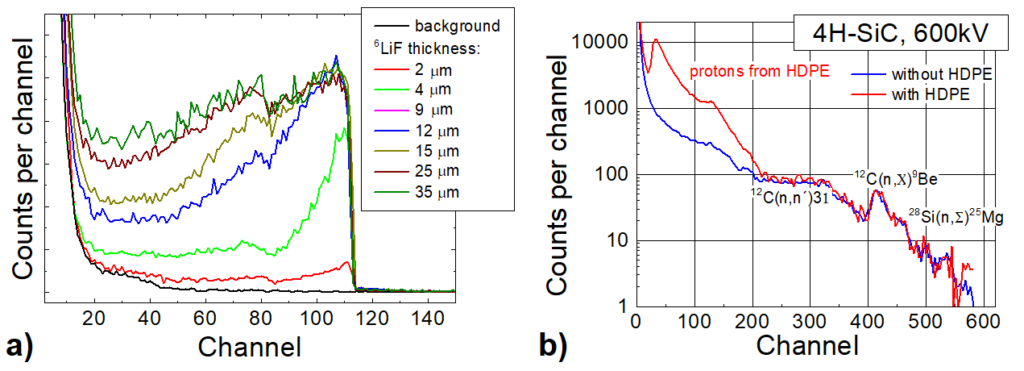We have prepared and optimized 4H-SiC detector structures with Schottky contact for detection of fast and thermal neutrons. Typicaly used silicon detectors have short lifetime due to high radiation damage coefficient of neutrons. New semiconductor materials with higher radiation resitance are demanded where SiC is one of the most importante candidate, which is able to operate also at high temperatures (more then several hundred of degrees Celsius). The expected utilization of SiC detectors is also close to nuclear or fusion reactors for monitoring of neutron flux. The conversion layer type is able to change sensitivity of detectors for various type of neutrons (like thermal or fast). Our goal was the optimization of electrical and detection properties using simulation tools and following realization of detectors and its experimental verification.

The spectral response of 4H-SiC detector of thermal neutrons with different thickness of conversion layer (left picture). The response of 15 MeV fast neutrons with and without HDPE conversion layer (right picture).
Outputs:
Zaťko, B., Šagátová, A., Sedlačková, K., Nečas, V., Dubecký, F., Solar, M., Granja, C., : Detection of fast neutrons from D-T nuclear reaction using 4H-SiC radiation detector. Inter. J. Modern Phys.: Conf. Ser. 44 (2016) 1660235.
Sedlačková, K., Šagátová, A., Zaťko, B., Nečas, V., Solar, M., Granja, C., : MCNPX simulations of the silicon carbide semiconductor detector response to fast neutrons from D-T nuclear reaction. Inter. J. Modern Phys.: Conf. Ser. 44 (2016) 1660226.
Zaťko, B., Šagátová, A., Sedlačková, K., Boháček, P., Sekáčová, M., Kohout, Z., Granja, C., Nečas, V., :Radiation detector based on 4H-SiC used for thermal neutron detection. J. Instrument. 11 (2016) C11022.
Zaťko, B., Hrubčín, L., Šagátová, A., Boháček, P., Dubecký, F., Sedláčková, K., Sekáčová, M., Arbet, J., Nečas, V., and Skuratov, V.: Particle detectors based on 4H-SiC epitaxial layer and their properties In: ASDAM 2016. Eds. Š. Haščík et al. IEEE 2016. ISBN 978-1-5090-3081-1. P. 141-144.
 Contact
Contact Intranet
Intranet SK
SK

